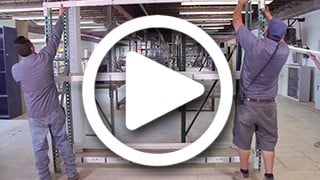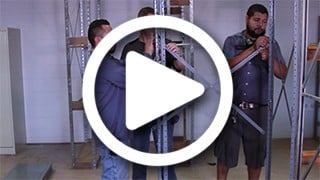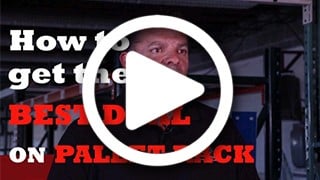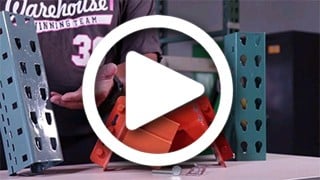5 Creative Warehouse Storage Solutions to Improve Efficiency
Creativity is essential in today's competitive and highly demanding market. As new supply chain challenges emerge, businesses must be prepared to make the most of every advantage available. Within the warehouse environment, this means strategically using every inch of floor space — and optimizing all processes to avoid wasting valuable time or resources.
While the status quo may have worked for your warehouse in the past, creative warehouse storage solutions are becoming vital across all sectors. If your business has long relied on a specific setup, however, you may struggle to make changes. To help, we've highlighted several creative strategies you might not have considered thus far:
1. Streamline your Current Warehouse Storage Practices
 If you've yet to implement lean strategies into your warehouse management system (WMS), it's time for a change. This approach aims to minimize resource consumption without causing problems with efficiency or accuracy. Under this system, any process that uses resources but doesn't provide clear benefits should be changed or eliminated.
If you've yet to implement lean strategies into your warehouse management system (WMS), it's time for a change. This approach aims to minimize resource consumption without causing problems with efficiency or accuracy. Under this system, any process that uses resources but doesn't provide clear benefits should be changed or eliminated.
Lean warehousing begins with a thorough assessment. To begin, determine whether you actually need to store as much product as your warehouse currently handles. Many enterprises overdo this, thereby wasting valuable warehouse space on products that take far too long to sell.
In addition to quantity, examine the quality of your inventory. Unnecessary products or equipment may need to be phased out to make room for more valuable items.
If you're happy with your product lineup and current equipment, assess your warehouse design and storage system. A just-in-time mindset may pay dividends; under this setup, inventory only arrives as customers demand it.
2. Upgrade Your Pallet Racking System
 A crucial component of modern warehouse storage, pallet racking provides easy access to necessary products or materials. A typical system stores numerous flat structures (known as pallets) either horizontally or in several levels.
A crucial component of modern warehouse storage, pallet racking provides easy access to necessary products or materials. A typical system stores numerous flat structures (known as pallets) either horizontally or in several levels.
Pallet racking takes many forms. Selection will depend on the size of the items or pallets, the amount of space available, and the desired pace of retrieval. Top options worth considering include:
- Drive-in pallet racking. A high-density setup that makes the most of limited space, drive-in racking allows forklift operators to navigate within the storage racks, which function a lot like lanes. This is common for last in, first out (LIFO) functionality.
- Push back pallet racking. Also ideal for LIFO arrangements, push back systems incorporate gravity with help from rollers. To begin, pallets are placed near the back — but they are pushed forward until they reach the front for easy loading.
- Pallet flow racking. Loaded from the rear, pallet flow systems use gravity and rollers. Unlike push back solutions, however, this type of racking involves loading from the rear. It is classified as a first in, first out (FIFO) approach.
- Selective pallet racking. Direct access to SKUs is often easiest under a selective pallet racking setup. It’s important to know that this does come at the cost of storage density.
- Double deep pallet racking. Limiting the need for dynamic systems, double deep arrangements maximize capacity by placing sections of selective racks back to back. Specialized forklifts may be needed to access some pallets stored under this approach.
- Cantilever racking. Oddly-shaped items can benefit from cantilever racks, which anchor to the warehouse floor and use upright columns with attached arms. These optimize retrieval while keeping items off the floor.
3. Use Vertical Space
 Vertical space is shockingly underutilized within the modern warehouse. As such, it provides some of the most impressive opportunities for boosting storage capacity without dramatically increasing operational expenses.
Vertical space is shockingly underutilized within the modern warehouse. As such, it provides some of the most impressive opportunities for boosting storage capacity without dramatically increasing operational expenses.
This is where creative optimization shines. These strategies must be carefully tailored to the needs of the facility in question, as not all vertical opportunities will be safe or effective in all spaces. Potential solutions include:
- Implement mezzanines. Many warehouses now incorporate supplementary floors, which are placed between the main floor and the ceiling of the facility in question. Known as mezzanines, these are often used for packaging and administrative tasks. They are highly versatile and easy to install, so they're ideal for today's quickly-evolving warehouses.
- Store items above the dock. The area immediately above the warehouse dock is often neglected. Conventional racking can be added here to maximize storage space. Some facilities may be better suited to suspended pallet racks or even offset solutions mounted to the wall.
- Reconfigure shelving. How high is your pallet racking setup? In all likelihood, you can increase the height of your storage system without compromising safety or retrieval times. A lot will depend on the height of the ceiling, the scope of your material handling equipment, and, of course, fire codes. If you can safely add a level, however, you could achieve high-density storage at minimal cost.
4. Recycle or Use Old Equipment
 Do you actually use all the equipment currently housed in your facility? Or does some of it sit dormant, occupying valuable space? It's common for businesses to continue to store bulky vehicles or devices long after they're no longer needed — and even after upgrading to newer models. Instead, consider selling, donating, or recycling unused equipment.
Do you actually use all the equipment currently housed in your facility? Or does some of it sit dormant, occupying valuable space? It's common for businesses to continue to store bulky vehicles or devices long after they're no longer needed — and even after upgrading to newer models. Instead, consider selling, donating, or recycling unused equipment.
At Warehouse1, we're pleased to offer a variety of buy back opportunities, which can help your business expand, downsize, or simply improve space utilization. We're committed to helping you buy back material handling equipment purchased from us — and making the process as straightforward as possible.
5. Reconsider Your Warehouse Layout
 Your previous layout may have served you well for years, but there's always room for improvement. New products, seasonal trends, or automated systems may prompt the need for layout reconfiguration. These could make your warehouse not only more efficient, but also, far safer. Modest adjustments can make a huge difference.
Your previous layout may have served you well for years, but there's always room for improvement. New products, seasonal trends, or automated systems may prompt the need for layout reconfiguration. These could make your warehouse not only more efficient, but also, far safer. Modest adjustments can make a huge difference.
As we've discussed, pallet racking solutions will play heavily into this. Don't be afraid to experiment with new technologies or concepts (such as automation) that go beyond the pallet storage categories described above.
Warehouse1: Your Trusted Resource for Creative Warehouse Solutions
Do you feel inspired by the pallet rack storage and layout solutions highlighted above? Our experts at Warehouse1 can help you select the best options for your warehouse or distribution center.
We'll work closely with you to determine your objectives — and to provide insight into hidden opportunities to boost your storage space and general warehouse productivity. Contact us today to learn more.
Credits: Warehouse worker photo created by aleksandarlittlewolf - www.freepik.com
"Forklift Delivery" by ericmerrill is licensed under CC BY 2.0



